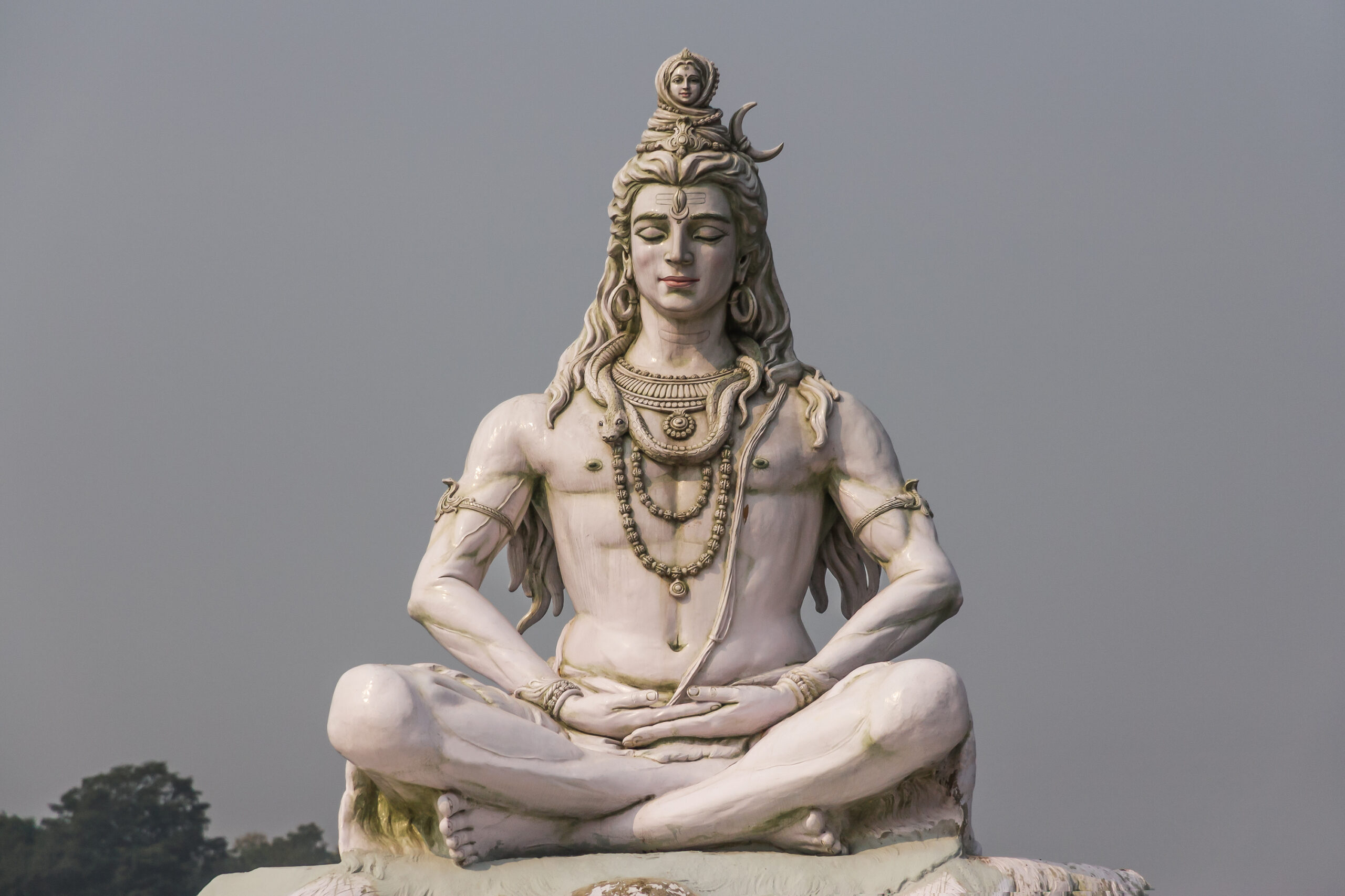
Shiva, according to a 2021 PEW study on religion in India, is the god Hindus most commonly feel close to, making his influence unquestionably vast in a religion containing some 1.2 billion adherents.
But what if I told you there are many (and I mean many) more around the world who are being influenced by him whether they’re aware of it or not — yes, including those who don’t consider themselves Hindu?
If you practice yoga, you’re one of them.
What has now become a multi-billion dollar fitness industry engaged in by roughly 300 million people worldwide, yoga is authentically part of the Hindu tradition, and reveres Shiva as Adiyogi, or its originator and first teacher.
Because he’s a god who is undisturbed by life’s dualities (like hot/cold, ugly/beautiful, and pain/pleasure) he is always in a deep state of meditation, or absorbed in connection with the Divine. Yoga, meaning “union” in Sanskrit, is accordingly a spiritual practice first and foremost, designed to calm and focus the mind so we can look inwards to the Divine reality that exists within us.
And so even for those who practice yoga strictly for its physical benefits, every time they perform a yoga asana (posture), they are connecting to a tradition that owes its existence to Shiva, making them a recipient of his immense compassion.
To thus honor Shiva — as it’s through appreciating his compassion we can get the most out of our practice — let’s learn a little about three asanas attributed to him, and the powerful meanings behind them.
Natarajasana
Time, according to Hindu texts, isn’t linear, but cyclical in nature. The universe is therefore said to be in constant flux, going through a continuous process of being created, maintained, and destroyed, much like the waves of an ocean that rise, fall, and crash, only to be pulled back by the ocean to rise once again.
Though such crashing can result in violent disarray and chaos, it is ultimately part of a larger process that is coherent and structured. What we see as a wave is really the interaction of energy in the water, caused by wind with the underlying bed of the ocean. Steadfast, stable, and peaceful, Shiva is much like this bed, supporting the shakti, or energy, that causes the wave’s existence. The pull and push of the swells along a beach hence has a rhythm to it that can be likened to a dance — the movements of which seem unpredictable and random at times, yet always in ultimate harmony with the beat of a drum, or the playing of music.
As such, the universal process is also described as a dance, one that sees its climactic crash at the time of cosmic renewal, when Shiva, who is known as Nataraja, or “Lord of the Dance,” performs a divine dance of transformation, paving the way for creation to begin anew.
Inspired by this dance, Natarajasana is a challenging position in which a person stands on one leg, and while keeping the chest out, reaches backwards to grab the foot of the other.
Demanding strong balance, the pose draws on our capacity to stand firm as we let go of our negative emotions, so that we can find the inner peace required to cultivate the positive ones necessary for spiritual advancement.
Bhairavasana
Following Shiva’s dance of transformation, Brahma, the architect of the universe, is believed to reconstruct creation, after which Vishnu, the god of preservation, assumes the role of its maintenance — before Shiva brings an end to it yet again, as the cycle repeats.
Working, therefore, in harmony to facilitate a cycle that serves and benefits everyone, all three gods play equally vital roles in the universal process.
But according to a Hindu text called the Shiva Purana, Brahma, proud of his position as the creator, once thought he held the most power and importance, so much so that if he wanted, he could perform even the work of the other two. In such a mood, he thus began flexing his abilities, emulating some of Shiva’s prowess to the point of encroaching on his duties.
Though tolerant at first, when Shiva realized Brahma had no intention of subsiding, he eventually lost his patience. Unwilling to take anymore, he removed a nail from his finger and threw it to the ground, generating a terrible and fearsome being named Bhairava, who upon manifesting, headed straight for Brahma and swiftly cut off one of his five heads, famously leaving him with four.
Utterly subdued, Brahma understood the error of his ways. Humbled, he prostrated himself before Bhairava, expressing his deep gratitude for the lesson, and the promise to keep his ego in check, remembering that Divine power is only great to the extent it’s used for the selfless service of others.
Dedicated to Bhairava, the frightful aspect of Shiva who cuts pride, Bhairavasana is an acutely potent side-plank with one leg behind the head, requiring intense focus as it combines balance, strength, and flexibility.



Virabhadrasana
Regularly seen covered in crematorium ashes with scattered hair, a garland of skulls, and a myriad of ghostly associates, Shiva is not depicted as your typical god, to say the least, making him an oft misunderstood deity to the unfamiliar.
The truth, however, is that he’s so beyond the dualities that affect most of us, he is at peace no matter what his surroundings are. In a state of complete bliss, he happily accepts even the most adverse environments, bestowing his compassion on those viewed as the least worthy. Of course, the erroneous tendency to judge a book by its cover has led some to deem him just as unworthy. Legend has it one such person happened to be his very own father-in-law, a king named Daksha.
Once, as the story goes, Daksha — unhappy with his daughter Sati’s marriage to Shiva, whom he was jealous of — hosted a grand event, and spitefully left them off the invite list. While Shiva was completely unfazed by the obvious slight, Sati, who was eager to see her friends and family, went anyway, hoping for the best. But after she arrived and it became apparent her father was deliberately ignoring her due to her marriage, she seethed with anger. Ashamed to be the daughter of someone so offensive, she ended her life through yogic means.
When Shiva heard of his wife’s death, he too grew irate. Though willing to withstand any insult to himself, insults to his devotees — especially as great as Sati — were intolerable. Standing up with fury, he plucked a hair from his head, creating from it a devastating entity who burned with the intensity of the sun and touched the sky with his immensity.
Carrying various weapons, the being, called Virabhadra, went straight to the sight of Sati’s death, apprehended Daksha, and killed him. Witnessing the act, those who were there in support of Daksha, fearfully left and approached Shiva, begging his forgiveness. Pleased by their humble mood, Shiva returned with them to his father-in-law’s body and revived him. Thereby regaining life, Daksha’s heart transformed at the sight of his son-in-law. Ashamed of his actions, he offered the sincerest of prayers, to which Shiva graciously accepted. In yoga, Virabhadrasana is thus a series of three powerful poses based on the warrior manifestation of Shiva who transforms the heart by destroying envy, ignorance, and delusion.
The first, known as warrior I, is among yoga’s foundational asanas, guiding one into a lunge with the front knee at a 90-degree angle, the hips squared, and the arms raised overhead — palms facing each other or together. The second pose (warrior II) keeps the same lunge as in warrior I, but the arms extend out in opposite directions as the gaze focuses over the forward shoulder. And for the third pose (warrior III), the back leg lifts into the air until the arms, torso, and leg are parallel with the ground.
Symbolizing the warrior’s preparation and movement for battle, these postures — which can be practiced separately or in succession — energize the body and mind, helping us to remain vigilant against life’s spiritual impediments.
If you enjoyed this piece, then you may also be interested in reading “The Hindu roots of yoga: Surya Namaskar“










































